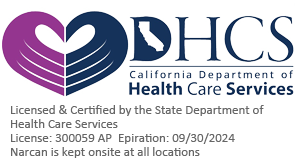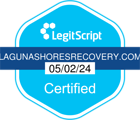Hydrocodone is one of the most commonly prescribed opioid medications in the United States, but its potential for misuse and dependence makes it a serious concern. Many people wonder, How long does hydrocodone stay in your system? This is a question that’s especially important for those facing drug tests, managing prescriptions, or beginning recovery.
At Laguna Shores Recovery Center in Dana Point, California, we understand that the effects of hydrocodone go beyond its presence in the body. Understanding this can also help patients and their families make informed choices about medications and recovery. Our comprehensive addiction treatment programs provide medical support, counseling, and holistic care to help individuals safely overcome opioid dependence and build a foundation for long-term recovery.
What is Hydrocodone?
Hydrocodone is a prescription opioid commonly used to relieve moderate to severe pain, often combined with acetaminophen in medications such as Vicodin or Norco. While effective for short-term pain management, hydrocodone carries a high risk of misuse due to its ability to produce feelings of euphoria. Side effects may include drowsiness, constipation, dizziness, nausea, and slowed breathing.
Over time, repeated use can cause the body to develop tolerance, meaning higher doses are needed to feel the same effects. This often leads to physical dependence and, in many cases, addiction. Breaking free from hydrocodone misuse can be challenging without professional help, making treatment and support essential to achieving lasting sobriety.
How Long Does Hydrocodone Stay in the Body?
Hydrocodone is a prescription pain medication that belongs to a group of drugs called semi-synthetic opioid analgesics. These medications treat moderate to severe pain and are found in common brand names such as Vicodin, Norco, and Lortab.
The half-life of a drug tells us how long it takes for half of the medication to leave your bloodstream. For regular hydrocodone pills, this happens in about 3.8 to 6 hours. Extended-release versions take longer, typically around 7 to 9 hours.
Here’s what makes this confusing: the pain relief from hydrocodone lasts 4 to 6 hours with regular pills, but the drug stays detectable in your body much longer. Even after the pain relief stops working, small amounts remain and show up on drug tests.
How long hydrocodone stays in the system depends on several factors, such as which type you take, how long you’ve been using it, and your individual health. The detection time varies significantly between different types of tests.
How Long Does Hydrocodone Stay in Urine, Blood, Saliva, and Hair?
Hydrocodone appears on drug tests long after its pain-relieving effects wear off. The detection window depends on which test is used and your personal factors.
| Testing Method | Detection Window | What Affects Detection
|
| Urine | 2-4 days | How much water you drink, your metabolism speed, and how often you use it |
| Blood | 24 hours | Liver health, dose amount |
| Saliva | 12-36 hours | Mouth pH, smoking |
| Hair | Up to 90 days | Hair growth rate, chemical treatments |
Urine tests look for hydrocodone at levels of 300 nanograms per milliliter (ng/mL) or higher to call a result positive. This answers common searches like “how long does hydrocodone stay in urine. The exact time depends on:
- Hydration levels: More water can dilute urine
- Metabolism speed: Faster metabolism clears drugs quickly
- Usage frequency: Regular use extends detection time
How long does hydrocodone stay in urine? Typically, 2 to 4 days after your last dose. People who use hydrocodone regularly or take higher amounts may test positive for up to 7 days.
Blood tests find hydrocodone for about 24 hours after your last dose. Doctors don’t use blood tests as often because the detection window is short. These tests usually happen in specific medical or legal situations.
When people ask “how long does hydrocodone stay in your bloodstream,” they’re referring to this 24-hour timeframe.
Saliva tests detect hydrocodone for 12 to 36 hours after use. These tests are less invasive than blood draws but catch the drug for a shorter time. Your mouth’s natural pH and oral hygiene habits can change the results.
Hair tests can find hydrocodone for up to 90 days. These tests look for long-term or repeated drug use rather than recent use. Hair growth rate and environmental contamination can affect results. Hair tests don’t show if you’re currently under the influence.
How Long Does Hydrocodone Last in Your System Versus Detection?
There’s an important difference between how long hydrocodone works and how long it stays detectable. Regular hydrocodone provides pain relief for 4 to 6 hours. Extended-release forms work for 12 hours or longer.
How long does hydrocodone last in your system? The effects are much shorter than the detection time. After pain relief stops, hydrocodone and its breakdown products remain in your body and show up on tests for days or weeks. The hydrocodone withdrawal timeline looks like this:
- Pain relief effects: 4-6 hours (regular pills)
- Extended-release effects: 12+ hours
- Detection in tests: Days to weeks, depending on test type
- Withdrawal symptoms: Start 8-24 hours after last dose
This explains why “how long does a hydrocodone stay in your system” has different answers depending on what you’re asking about.
Factors That Affect How Long Hydrocodone Stays in the System
How long hydrocodone stays in the system varies from person to person. Several factors determine how long hydrocodone remains in your system.
People with faster metabolism process hydrocodone more quickly. Metabolism is how your body breaks down and removes substances like medications. Older adults often have a slower metabolism, making hydrocodone stay in their bodies longer.
Your genes also matter. The CYP2D6 enzyme breaks down hydrocodone, and genetic differences make this happen faster or slower for different people.
Higher doses and regular use make hydrocodone detectable longer. Repeated use causes the drug to build up in your system. This affects how long hydrocodone stays in your system compared to occasional, lower-dose use.
Your liver breaks down hydrocodone while your kidneys remove it through urine. Healthy liver and kidney function speed up this process.
Water intake affects urine concentration and may change detection times. Body size and composition also influence how long hydrocodone stays in your system—people with more body fat or larger size may process drugs differently.
Does Hydrocodone Show Up in a Drug Test?
Hydrocodone can appear on drug tests, but not all tests look for it specifically. The answer to “Does hydrocodone show up in a drug test?” depends on the test type. Drug tests use different methods, including:
- Immunoassay screening: An Initial test that may react to similar substances
- GC-MS/LC-MS confirmation: More accurate follow-up test
- Standard panels: May or may not include hydrocodone
- Expanded opiate panels: More likely to detect hydrocodone
Basic drug test panels sometimes only check for natural opiates like morphine and codeine. In these cases, hydrocodone might not be detected unless a more comprehensive test is ordered.
Cross-reactivity happens when tests react to chemically similar substances, which can cause confusing results. Confirmation testing verifies positive results from initial screens.
For “does Norco show up on a drug test,” the answer is yes when tests look for hydrocodone, since Norco contains hydrocodone as its main ingredient.
How to Get Hydrocodone Out of Your System Faster
The safest approach is letting your body naturally process and eliminate hydrocodone. Attempting to manipulate test results or speed up drug removal using unproven methods can be dangerous and illegal.
For those wondering how to get hydrocodone out of your system faster, here are the only safe approaches:
Drinking adequate water supports your kidneys as they filter waste from your blood. Your kidneys naturally remove medications like hydrocodone through urine.
Drinking excessive water in short periods can cause water intoxication, which is dangerous.
Stopping opioids like hydrocodone can cause withdrawal symptoms. Medical professionals can monitor your health and manage symptoms that may occur during this process.
Once you stop taking hydrocodone, your body begins clearing the drug naturally. Continued use keeps extending detection times. Treatment programs at facilities like Laguna Shores Recovery help people who want to stop using hydrocodone or have developed dependence.
Hydrocodone in Urine FAQs
Norco contains hydrocodone plus acetaminophen, so drug tests detect the hydrocodone component the same way they would detect pure hydrocodone.
Environmental or second-hand exposure to hydrocodone does not cause positive drug test results. The medication must be ingested to appear in detectable amounts in your body.
Drug tests cannot distinguish between prescribed and non-prescribed hydrocodone. The chemical compound appears identical regardless of how it was obtained.
Extended-release formulations may remain detectable slightly longer because they release hydrocodone slowly over time, potentially extending the presence in your body.
Moving forward, professional support helps individuals facing hydrocodone dependence. Laguna Shores Recovery provides detoxification, residential treatment, and aftercare programs. Contact us to learn about treatment options or verify your insurance coverage.

 Matthew Beck B.A, M.A, LMFT
Matthew Beck B.A, M.A, LMFT 


